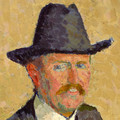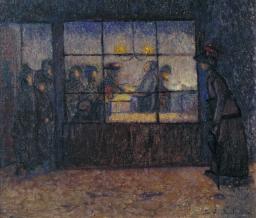Frank Rutter, ‘Round the Galleries’
Sunday Times, 3 December 1911, p.16.
ROUND THE GALLERIES.
Embarras des Richesses.
Never do I remember so many genuinely interesting art exhibitions opening in London within a few days of each other as during the past week. Before I had time to finish what I was saying about the New English Art Club, opens at the Stafford Gallery (1, Duke-street, St. James’) a wonderful exhibition of paintings by Cézanne and Gauguin, most of them never seen in England before, choice loans from the superb collection of M. Vollard. Hot on its heels open a comprehensive exhibition of paintings, drawings, and etchings by Mr. Augustus John at the Chenil Gallery (183a, King’s-road, Chelsea), a collection of oil paintings and pastels by that gifted but sadly neglected painter, the late William Stott, of Oldham, at Mr. van Wisselingh’s Gallery (14, Grafton-street), and the second exhibition of “The Camden Town Group” at the Carfax Gallery (24, Bury-street, Jermyn-street). Adequately to deal with any one of these exhibitions would more than exhaust my allotted column, and in the middle of all this a promising young Australian painter, Mr. Horace Brodzky, opens to the public an exhibition of his individually viewed “Italian and Sicilian Pictures” at 9, Trafalgar-studios, Manresa-road, Chelsea, while at the Baillie Gallery (13, Bruton-street) Miss Dora Boughton Leigh shows spirited watercolours and drawings of “The Cotswolds and Elsewhere,” and my old friend Stephen Haweis, after years of self-exile, returns from Florence with seventy-three paintings to show, in the same gallery, how after passing through Whistler, Conder, and Morrice phases he has won a way to self-expression in a series of decorative fantasies (23, 9, 40, 42, 64, 69). Having already, to some extent, had my say on Cézanne and Gauguin in my little pamphlet on “Revolution in Art,” I would gladly pass on to the living painters had not this Stafford Gallery exhibition been made almost a personal matter in certain quarters.
C[é]zanne.
Mr. Robert Ross, for example, having now accepted Gauguin, publicly invites me to argue “whether Cézanne’s pictures are charming or beautiful or interesting.” Before I take up the challenge I must ask Mr. Ross to define exactly what he means by “beautiful” and “charming.” Personally I consider these adjectives meaningless in art criticism; they have no universal significance and usually denote no more than a personal liking on the part of the writer which he is either impotent or too lazy to analyse. An Italian at heart, Mr. Ross is inclined to associate his idea of beauty with form rather than character, and naturally finds himself more in sympathy with the formal grace of Gauguin than Cézanne’s expression of character. Some two years ago I pointed out that Gauguin was essentially a classic; roughly it may be said that he, especially in his later works, painted types, whereas Cézanne painted individuals. Gauguin will soon be popular, just as Raphael is popular – without being understood – for they really belong to the same race. But what is really astounding is that nobody here appears to recognise that Cézanne is akin to Rembrandt, that they also belong to the same family. Yet look at that splendid Cézanne landscape “The Bridge” (7), so intrinsically interesting in its expressive simplicity and utter freedom from any kind of trickery, so pregnant as the matrix from which Derain, Marquet, Vlaminck, and others have evolved their own individual art; and then go to South Kensington and study the bridge in Rembrandt’s “Landscape with Canal.” If this is not enough to establish the relationship, then turn your attention to Rembrandt’s well-known “Sketch of a Man in a Wide Hat.” If an extraordinarily honest summariness of expression “interests” you in the work of Rembrandt, I see not how logically you can withhold interest from a similar quality in the work of Cézanne.
Gauguin.
To another critic “the show at the Stafford Gallery seems devoted in part to displaying the close connection between Gauguin and Cézanne.” Remembering the preceding exhibition in Duke-street it would have been truer to say that it shows the connection of the two with Camille Pissarro. Certainly it is misleading to say that Gauguin “had his root” in Cézanne. Nothing of the kind. Anyone who looks at Nos. 13 and 14 at the Stafford Gallery, early works painted respectively in ’81 and ’83, should be able to recognise at once that Gauguin had his root in Camille Pissarro. The trouble is that owing to the supineness of officialism we are abysmally ignorant of modern French art. Very few people, certainly few of those who write and talk of them, have any intimate knowledge of the earlier Impressionists. When they were first shown here Pissarro was scandalously overlooked and neglected, and now we are paying for our ignorance and obtuseness by all the muddle that is being made over the great painters to whom he gave birth. This is not a matter that anybody can “argue” about; it is a question of knowledge, knowledge of the work of Pissarro and of the early paintings of Gauguin. I have no leisure to break further lances with my confrères, but before turning to the living I must express the pleasure with which I find myself agreeing with Mr. Ross that the lucky purchaser of Gauguin’s superb nude “L’Esprit Vieille” (22) is “one of the best known collectors in England and one of the wisest” – may I hope he will also be one of the most public-spirited by leaving this to the nation? – and echoing his advice that anyone who missed the Grafton show last autumn “should make a point of visiting the Stafford Gallery.”
The Camden Town Group.
If the Stafford Gallery deserves gratitude for exhibiting interesting movements at Paris thirty years ago, how much greater should be our thanks to the Carfax and Chenil galleries for showing hospitality to the most interesting movements of to-day? The two exhibitions may be taken together, for the movement of which Mr. John is the protagonist overflows into the Carfax Gallery where it finds its most downright and uncompromising exponent in Mr. Wyndham Lewis. For summary expression his “Port de Mer” (35) is the British advance-post, a blaze of yellow for sunlight, three extraordinarily simplified but cunningly placed figures to symbolise the picturesque loafing of fishermen at rest. Clumsy as classification must always be in dealing with artists so individual as the members of this group, they may loosely be divided into two sub-groups. The difference between them is more a difference of approach, of technique, than of aim. There are the painters who desire to give “a bare statement of the essence of the subject,” Mr. Lewis, the extremist, Mr. Lamb, Mr. Innes and Mr. Duncan Grant, whom we are glad to see admitted to the circle and hope to see more fully represented at the next show. Mr. Walter Bayes (50) leans towards this sub-group, and so does Mr. Doman Turner. The other sub-group is headed by Messrs. Lucien Pissarro, Spencer Gore and Walter Sickert. It is most instructive to compare the last’s early painting of “The Old Hotel Royal” with his quite recent “Mother and Daughter,” and see how Sickert has bottled Whistler, and after fermenting him with Pissarro, produced an entirely new sparkling beverage of his own. Gore, by a strange alchemy known only to himself, has produced another sparkling brand and gives us an exquisite draught of colour in his iridescent “Mad Pierrot Ballet.” A similar sparkling colour characterises the two nudes (20, 22) by Mr. Gilman and Mr. Drummond’s vital and characteristic “Portrait of Charles Ginner.” The results obtained by these artists are all very different, but their method of approach is the same, an intimate analysis of colour and the building up of a picture by a mosaic of touches. Mr. J. B. Manson and Mr. Ratcliff [sic] employ the same method. Mr. Ginner is nearly allied to this sub-group, but, if I may pursue the wine analogy a little further, I would liken his “Café” and “Sunlit Quay” to that generous, full-bodied burgundy that glows and bubbles and is yet a still wine. Mr. Bevan, for all the sweep of his design, also builds up his masterly cab-scenes (31, 32) by small touches of pigment. En parenthèse, Mr. Ross can say what he likes of Cézanne if only he will persuade the Contemporary Art Society to get one of these Bevans for the nation before they all go to more appreciative collectors in France and America.
FRANK RUTTER.
How to cite
Frank Rutter, ‘Round the Galleries’, in Sunday Times, 3 December 1911, p.16, in Helena Bonett, Ysanne Holt, Jennifer Mundy (eds.), The Camden Town Group in Context, Tate Research Publication, May 2012, https://www


